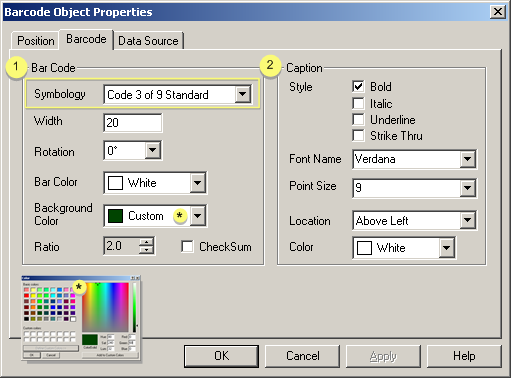Code 39 is variable length and is the most frequently used symbology in industrial bar code systems today.
The principal feature is to encode messages using the alphanumeric character set.
Select the Barcode tab in the Barcode Object Properties dialog box.
Select Code 3 of 9 Standard in the Symbology field.
Note: Code 3 of 9 Standard is a one-dimensional bar code type.
Fill in the fields as follows.

|
|
Option |
Description |
|
|
|
Width |
Bar code width from left to right in points |
|
|
|
Rotation |
Options going counter-clockwise are: |
|
|
|
|
0o |
No rotation |
|
|
|
90o |
Left-Vertical |
|
|
|
180o |
Upside down |
|
|
|
270o |
Right-vertical |
|
|
Bar Color |
Color of the bar characters. |
|
|
|
Background Color |
Color of the area behind the bars that is background. |
|
|
|
Ratio |
Range |
2.0-3.0 |
|
|
|
Default |
2.0 |
|
|
Checksum |
Checked |
Any checksum that is specific to any implementation has to be done outside the scope of broadcast, and should be part of the data made available to broadcast. |
|
|
|
Default |
Clear |
|
|
Style |
Available features for the caption font are:
|
|
|
|
Font Name |
Selected font for the caption. This font can be a standard font (different from the bar code font) so it can be easily read. |
|
|
|
Point Size |
Size in which the caption font will display. The caption font displays within the space allocated for the bar. Therefore, the larger the font the more space it uses and the less space there is to display the bar. You can increase the space for the bar or decrease the font size if the bar is smaller than you want. |
|
|
|
Location |
Caption font position relative to the bar. Options are. |
|
|
|
|
|
|
|
|
Color |
Color of the caption font. |
|
|
Colors can be customized through the Color palette. |
|||
|
|
Select Custom in the Color field to display the palette. |
||
Select the Data Source tab.
Click Static.
Make a valid entry in the Text box.
Note: Also make sure that values from other data sources adhere to these requirements.
|
Requirements |
Description |
|
Valid characters |
Six special alphanumeric characters. |
|
|
Capital letters A through D |
|
|
All numeric digits |
|
Length |
Variable |
Options for Code 39 symbology include
|
Option |
Description |
|
Full ASCII |
Standard Code 39 contains only 43 characters as follows. 0-9 A-Z $ / % + Code 39 can be extended to an 128 character symbology (full ASCII) by combining one of the special characters ($, /, %, +) with a letter (A-Z) to form the characters that are not present in the standard Code 39 symbology. Example In standard Code 39 a lowercase a cannot be represented. In Code 39 Full ASCII a lowercase a is represented as +A. |
|
Check Digit |
A modulo 43 check character can be used to enhance data security for Code 39 symbols. The last digit of the symbol is assumed to be the check digit; it is compared to a calculated check digit to verify the symbol. |
|
Append |
It is sometimes advantageous to break up long messages into multiple, shorter symbols. If the first character of a Code 39 symbol is a space (ASCII 32), then the scanned symbol is appended to a storage buffer. This operation continues for all successive Code 39 symbols with a leading space being added to previously stored ones. When a Code 39 symbol that does not include a leading space is scanned:
|
Click .
Click .
Result: The bar code displays your static text specifications.
|
Step 6.4. Configure the bar code symbology. |